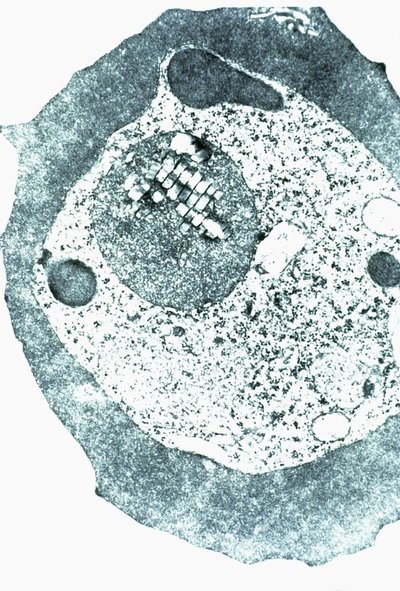March 30, 2000
Magnetic fields may hold key to malaria treatment, UW researchers find
Researchers at the University of Washington have discovered a method of treating malaria with magnetic fields that could prove revolutionary in controlling the disease the World Health Organization calls one of the world’s most complex and serious human health concerns.
Henry Lai, UW research professor of bioengineering, says the malaria parasite Plasmodium appears to lose vigor and can die when exposed to oscillating magnetic fields, which Lai thinks may cause tiny iron-containing particles inside the parasite to move in ways that damage the organism.
“If further studies confirm our findings and their application in animals and people, this would be an inexpensive and simple way to treat a disease that affects 500 million people every year, almost all in third-world countries,” Lai said. According to the World Health Organization, as many as 2.7 million people die of malaria every year. Approximately 1 million of those are children.
In the past two decades, the emergence of drug-resistant malaria parasites has created enormous problems in controlling the disease. Lai says his method could bypass those concerns because it is unlikely Plasmodium could develop a resistance to magnetic fields.
Malaria is spread by female Anopheles mosquitoes. The organism first invades the liver, then re-emerges into the bloodstream and attacks red blood cells. This is what causes malaria’s hallmark symptoms: fever, uncontrolled shivering, aches in the joints and headaches. Infected blood cells can block blood vessels to the brain, causing seizures and death. Other vital organs are also at risk.
Lai’s research appears to take advantage of how the parasites feed. Malaria parasites “eat” the hemoglobin in red blood cells of the host. They break down the globin portion of the hemoglobin molecule, but the iron portion, or the heme, is left intact because the parasite lacks the enzyme needed to degrade it. This causes a problem for the parasite because free heme molecules can cause a chain reaction of oxidation of unsaturated fatty acids, leading to membrane damage in the parasite. The malaria organism renders the free heme molecules non-toxic by binding them into long stacks – like “tiny bar magnets,” according to Lai.
He and three other researchers have exposed Plasmodium falciparum, the deadliest of the four malaria parasite species, to a weak alternating, or oscillating, magnetic field. Data sets showed that exposed samples ended up with 33 to 70 percent fewer parasites than unexposed samples. Measurements of hypoxanthine, a precursor for nucleic acid synthesis used by the parasite, indicated that metabolic activities had also significantly slowed in exposed samples. Such reductions would be enough to manage malaria, Lai said.
The oscillating magnetic field may affect the parasites in two ways, according to Lai. In organisms still in the process of binding free heme molecules into stacks, the alternating field likely “shakes” the stacked heme molecules, preventing further stacking. That would allow harmful heme free reign within the parasite. If the parasite is further along in its life cycle and has already bound the heme into stacks, the oscillating field could cause the stacks to spin, causing damage and death of the parasite.
Although initially promising, Lai says more research is needed.
“We need to make certain that it won’t harm the host,” Lai said. “My guess is that it won’t. It’s a very weak magnetic field, just a little stronger than the earth’s. The difference is that it is oscillating.”
If the method is proven effective and safe, Lai envisions rooms equipped with magnetic coils to produce the oscillating field.
“It would be very easy. People could come to the room and sit and read or whatever while they’re being treated,” he said. “Or you could set it up in the back of a big transport truck, then drive from village to village to treat people.”
Collaborating researchers include Jean E. Feagin, UW associate professor of pathobiology and senior scientist at the Seattle Biomedical Research Institute; and Ceon Ramon, UW electrical engineering research scientist.
###
For more information, contact Lai at (206) 543-1071 or hlai@u.washington.edu. Copies of a background symposium paper on the research are available via fax from Rob Harrill at (206) 543-2580 or rharrill@u.washington.edu. A high-resolution image of the malaria parasite is available on the Web at: http://www.washington.edu/newsroom/news/images/malariacell.jpg.



